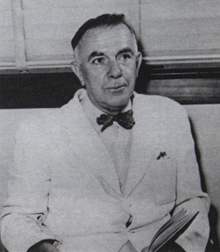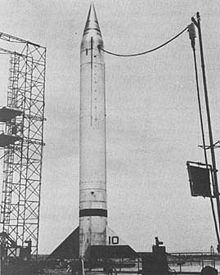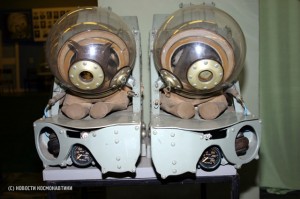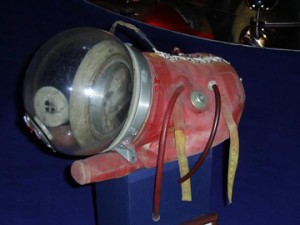February 9: The Department of Space Medicine was established at the School of Aviation Medicine, Randolph Field, Tex., by Col. Harry G. Armstrong. Dr. Hubertus Strughold subsequently became the first and only Professor of Space Medicine.
Ref – Harsch V. “Life, Work and Times of Hubertus Strughold, 1898-1986.” Rethra Verlag. Neubrandenburg, Germany. 2003. ISBN 3-937394-14-1, 188 pages, in German.
 Strughold Accomplishments (1.9 MiB)
Strughold Accomplishments (1.9 MiB)
 Strughold Controversy (125.0 KiB)
Strughold Controversy (125.0 KiB)
February 24: The fifth Bumper test at White Sands sent a V-2 to 63 miles, and a Wac-Corporal to 244 miles, a new record altitude above the Earth, and attained a record speed of 5,510 miles per hour. It measured ion densities in the upper atmosphere arid near space.
May 3: The US. Navy launched Martin Viking rocket No. 1 at White Sands to reach an altitude of 51.5 miles and a speed of 2,250 miles per hour. This single stage research rocket carried a payload of 464 pounds of instruments and had a 20,000 lb thrust engine. Twelve were eventually launched, the last on February 4, 1955. It was the first successful rocket with a gimbaled engine.
 Viking Launch List (3.2 KiB)
Viking Launch List (3.2 KiB)
May 11: President Truman authorized the Atlantic Missile Range at Cape Canaveral, Florida.
May: Two papers were presented at the Aero Medical Association meeting:
“Some Aviation Medical Problems Associated with Potential Rocket Flight” by Gen. Harry Armstrong, M.D. and “Cybernetics and Aviation Medicine” by Col. Paul Campbell, M.D.
September 1: The “Conquest of Space” by Willey Ley is published. It describes a Lunar landing using the Direct Ascent mode.
September 25: First launch of the R-2 from Kasputin Yar. The RD-101 engine (Glushko designed) had a thrust of 81,000 lbs and burned EtOH/LOX.
 R-2 Launch List (24.4 KiB)
R-2 Launch List (24.4 KiB)
During 1949-1952, the Soviet Union sent mice, rats and rabbits on several non-survival flights. They also launched six R-1 flights with nine dogs up to 100 kilometers, three of which made two trips each (each flight had two dogs). This was under the direction of the space biomedical expert, Vladimir Yazdovsky. The launch vehicles were directed by Sergei Korolev.
- August 15, 1951: Launch of the R-1 IIIA-1 suborbital flight with two dogs (Tsygan and Dezik). This first launch was successful.
- September 1951: Launch of R-1 flight with Dezik and Lisa. This second launch, as well as the forth launch, were both failures and the dogs did not survive.
- September 15, 1951: The sixth and last suborbital dog launch occurred which was successful and reached 100 km. Both dogs survived.
In total, 9 dogs were flown to an altitude of 100 km (62 mi) on board 15 scientific flights using R-1 rockets from 1951 to 1956. The dogs wore pressure suits with acrylic glass bubble helmets. From 1957 to 1960, 11 flights with dogs were made on the R-2A series, which flew to about 200 km (124 mi). Three flights were made to an altitude of about 450 km (310 mi) on R-5A rockets in 1958. In the R-2 and R-5 rockets, the dogs were contained in a pressurized cabin.
Journal of Aviation Medicine articles:
Armstrong, H G, Haber, H, Strughold, H. Aeromedical problems of space travel.
 20060383-1 (1.0 MiB)
20060383-1 (1.0 MiB)
Classics in Space Medicine –  Armstrong (415.5 KiB)
Armstrong (415.5 KiB)






